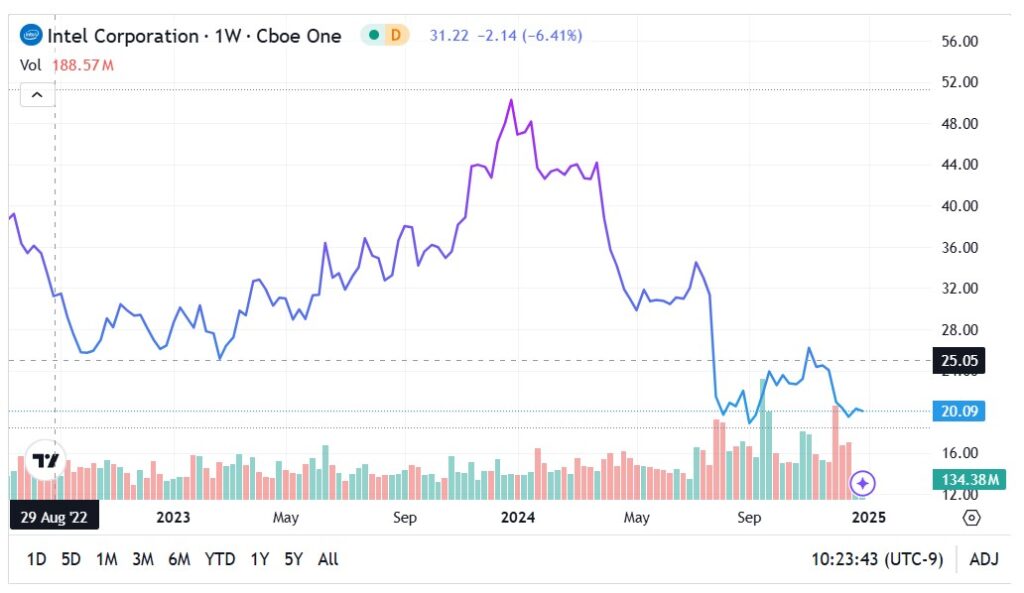Zinger Key Points
- Rising skepticism against Intel’s increasingly frantic business has sent Intel stock tumbling over the past few years.
- However, the bad news could already be baked in ahead of its upcoming Q4 earnings report.
- Find out which stock just claimed the top spot in the new Benzinga Rankings. Updated daily— discover the market’s highest-rated stocks now.
It doesn't take a rocket scientist to realize that semiconductor giant Intel Corp INTC is hurting.
Over the past 52 weeks, Intel slipped approximately 58%. A range of woes, from management miscues to brewing skepticism of its competitive viability, have clouded the once-proud tech juggernaut. However, it's also possible that — at least in the near term — the ugliness could already be baked in.
In early December, Intel's board reportedly forced out CEO Pat Gelsinger, which wasn't the most surprising development. While the chipmaker took significant steps — including a dramatic workforce reduction — to right the ship, the company's fiduciaries grew frustrated with Gelsinger's turnaround progress.
For the business week ending Dec. 6, Intel stock fell 15.78% — a reflection of deep uncertainty.
Last August, Intel stock suffered a seismic decline due to the semiconductor firm posting earnings per share of 2 cents for the second quarter, against an estimated print of 10 cents. Additionally, some analysts fretted over Intel's market share loss to the competition. At the same time, this bad news is now in the rearview mirror. Looking forward, the contrarian bulls may sense a deep-value proposition.
Technical and Statistical Trends May Favor Upside for Intel Stock
One of the key factors shining a bullish light on Intel stock is the discipline of technical analysis or using price movements to identify buy and sell signals.
Specifically, since the aforementioned August earnings fallout, Intel has printed a series of rising lows. Previously, the bulls managed to hold support at $19. At the moment, the optimists have dug themselves in at the $20 level.

This trend implies that investors are now attuned to any positive news. In other words, Intel has already suffered layoffs, leadership challenges and competitive headwinds, among many other concerns. Again, the dirty laundry has already been seen and accounted for. All it may take now is a modicum of positivity to spark a quick recovery.
Another element that might favor the upside for Intel stock is its statistical trend. Relatively speaking, large weekly drops in security are rare. Not including sessions from last month, in the past five years, there have only been eight weeks where Intel stock dropped 10% or more. Of this figure, only three instances saw Intel deliver a positive return by the end of the fourth subsequent week.
Put another way, investors generally steer clear of the chipmaker when it suffers badly over a one-week period. However, since the early December drop, Intel stock appears to have found its footing at the $20 support line. For intrepid speculators, this might be the signal to pull the trigger.
Laying The Groundwork For A Bull Call Spread
An enticing mechanism by which to speculate on INTC stock is an options strategy called the bull call spread. This approach calls for buying a call option and simultaneously selling a call at a higher strike price for the same expiration date. The idea is to use the credit received from the short call to partially offset the debit paid for the long call, thus discounting a net bullish position.
Conservative investors may want to consider the 18/20 bull call spread (buy the $18 call, sell the $20 call) for the options chain expiring Jan. 24, 2025. Fundamentally, the expiration date comes one day after Intel posts its Q4 earnings results. Should good news arrive, INTC stock will likely shoot higher. Investors can also close the position early, under the thesis of buy the rumor, sell the news.
However, in a bull call spread, a security moving significantly above the short strike price represents an opportunity cost as the maximum reward is capped at that particular price. For a more aggressive approach, investors may consider the 20/22 bull call spread for the Jan. 24 expiration date.
In this case, the maximum reward can be collected if INTC stock rises to $22 or above by expiration. Further, the $22 price point roughly splits the current support level and the prior support of approximately $25 which materialized in late 2022 and early 2023, making it a logical target.
Now Read:
Image: Shutterstock
Edge Rankings
Price Trend
© 2025 Benzinga.com. Benzinga does not provide investment advice. All rights reserved.
Trade confidently with insights and alerts from analyst ratings, free reports and breaking news that affects the stocks you care about.